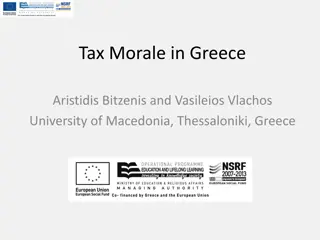Impact of Age Demographics on Maryland's Economic and Tax Outlook
Maryland's Bureau of Revenue Estimates, under the direction of Andrew Schaufele, explores the significant implications of changing age demographics on the state's economic and tax revenue projections. Through innovative data collection methods and detailed analysis, the bureau uncovers trends affecting tax bases and revenue streams, highlighting challenges and opportunities for policy adjustments.
Uploaded on Nov 26, 2024 | 0 Views
Download Presentation

Please find below an Image/Link to download the presentation.
The content on the website is provided AS IS for your information and personal use only. It may not be sold, licensed, or shared on other websites without obtaining consent from the author. Download presentation by click this link. If you encounter any issues during the download, it is possible that the publisher has removed the file from their server.
E N D
Presentation Transcript
1 THE IMPACT OF AGE DEMOGRAPHICS ON MARYLAND S ECONOMIC AND TAX REVENUE OUTLOOK Andrew Schaufele: Director, Bureau of Revenue Estimates
2 How We Added Value Initial Mission: Quantify the tax impact from the shifting age composition within our tax base Able to attach birthdates to our tax filing database Separated jointly filed returns into individuals Split income evenly Provides an accurate database for the Maryland population real data, no surveys or extrapolation Product is not a sample, every table and summary is derived from the full Maryland tax filing population Caveats missing those that don t file but earn income and use population estimates for certain metrics
3 Creation of the Boom
4 Nation and MD are Aging
5 Similar Pattern for Tax Filing Population
6 Most Productive Age Cohort Shrinking Largest Earners Declining as Share of Total
7 Slow Working Age Population Growth Saps Labor Force
8 Slow Working Age Population Growth Saps Labor Force
9 Immigration With no immigration since 1965*: US population in 2015 would be 252 million rather than 324 million Median age 41 rather than 38 With no immigration after 2015*: US population in 2065 would be 338 million and shrinking rather than 441 million and growing
10 Significant Impact on Revenues Already Costing ~ $100M already per year, 1.5% of PIT revenues Negative impact to grow annually, by 2035 costing ~ $300M per year (today s dollars), a 4.5% reduction in PIT revenues
11 Impacts Sales Tax Also Double Whammy: Older taxpayers spend less and younger taxpayers more likely to use non-nexus retailers and digital goods
12 Uncovered Problem Taxpayer Participation Rate (TPR) TPR = % of the population that files a tax return Joint filers are divided into individuals, income split evenly For Example: Number of Filers = 80 Population = 100 Therefore, TPR is 80% (80/100) Rate falling since 2007, no sign of abating through most recent data (2015) Further reduction in revenues On top of slowing and aging workforce Bigger problem than revenues tax participation symbolizes participation in society!
13 TPR Indexed to 2007
14 TY 2007 TPR 45 to 64
15 TY 2015 TPR 45 to 64
16 Conservative Estimate for TPR Impact (45-64) Avg Inc for irregular filers is $37k, 25% less regular filers # irregular filers decreasing over time, becoming non-filers



![Town of [Town Name] Real Estate Tax Rates and FY 2024 Budget Summary](/thumb/62211/town-of-town-name-real-estate-tax-rates-and-fy-2024-budget-summary.jpg)



















